





Illustrious Wonderers
Paul Scott UK, Kurt Weiser USA, Stephen Bowers AU
Exhibition October 30 - November 26 2010
Illustrations in porcelain from the Danish Stigsnæsværk to Arizona and Australia.
Humour, satire and story telling by three acknowledged international artists.
Paul Scott, Kurt Weiser and Stephen Bowers exhibit together for the first time at this exhibition in Copenhagen.
The viewer is guided wandering around the world and into each of the exhibitors personal magic place of illustrious porcelain.
The exhibition visualizes the cultural differences between Europe, America and Australia.
Here are pieces with an innocent elegance, that don't usually hold satire, social critique or political comments; but at a closer look the details open up for endless stories and meanings, and layer by layer reveal the artists knowledge and humour.

 Paul Scott is an artist known for his research into ceramics and print. He creates individual pieces that are exacting and critical, blurring the boundaries between fine art and design.
Paul Scott is an artist known for his research into ceramics and print. He creates individual pieces that are exacting and critical, blurring the boundaries between fine art and design.His work involves the digital manipulation of established vocabularies of printed motif, pattern and image from industrial ceramic archives and engraved book illustration. Cloning and collaging these, sometimes with photographic elements, he creates contemporary artworks in ceramic and printed form.
Paul Scott lives in a rural area, Cumbria, North West England. However, he has gained international prominence for his ceramic work as well as his ceramic research, writing and curating activities. In 2005 he was awarded a Phd Bursary at MIRAD, Manchester Metropolitan University (www.miriad.mmu.ac.uk) for his project: 'Ceramics Landscape Memory and Confection'.
Paul Scott tells about his work for this exhibition: “Soda and salt glazed cups, bowls and plates, together with wood fired trees are the results of a series of wood firings in Denmark and Hungary.
The wood fired objects play on the methodology of production, the resultant artefact and the words and language used to describe them. They are also beautiful objects - the flash of flame or soda/salt glaze and the bleeding cobalt print - expressive graphic qualities imbued by fire and process, complemented by gold splash or painted line...”
www.cumbrianblues.com
 Kurt Weiser is Internationally recognized as a contemporary ceramic artist and educator. Weiser is known for his technical virtuosity with porcelain forms and his use of china painting techniques in a distinct contemporary style. His subject matter illustrates lush, mysterious landscapes and distorted narratives set amidst colour-saturated flora and fauna that read as voyeuristic candid snapshots of the human condition.
Kurt Weiser is Internationally recognized as a contemporary ceramic artist and educator. Weiser is known for his technical virtuosity with porcelain forms and his use of china painting techniques in a distinct contemporary style. His subject matter illustrates lush, mysterious landscapes and distorted narratives set amidst colour-saturated flora and fauna that read as voyeuristic candid snapshots of the human condition. This exhibition shows a salt-fired earthenware vase complimented by a series of blue and white cups, tall cylindrical vases and a 'teapot' painted in black and white. The illustrations challenge and surprise the viewer all the way around the forms with a continuous dreamlike narrative. www.contemporarycraft.org/The_Store/Kurt_Weiser.html
This exhibition shows a salt-fired earthenware vase complimented by a series of blue and white cups, tall cylindrical vases and a 'teapot' painted in black and white. The illustrations challenge and surprise the viewer all the way around the forms with a continuous dreamlike narrative. www.contemporarycraft.org/The_Store/Kurt_Weiser.html Stephen Bowers ceramic pieces may reflect ideas about recollection and persistence in the form of remnants and shards; and be about how sections of memory survive; and utilise borders, patterns, overlaps, edges and shadows. He regularly retrieves and re-positions images, representing ‘the familiar’, often sourcing ‘clichéd’ images (i.e. blue and white, willow pattern, wallpapers, natural history illustrations, etc.) within a personal contemporary context, often with a surreal, whimsical, humorous, sceptical or satirical subtext.
Stephen Bowers ceramic pieces may reflect ideas about recollection and persistence in the form of remnants and shards; and be about how sections of memory survive; and utilise borders, patterns, overlaps, edges and shadows. He regularly retrieves and re-positions images, representing ‘the familiar’, often sourcing ‘clichéd’ images (i.e. blue and white, willow pattern, wallpapers, natural history illustrations, etc.) within a personal contemporary context, often with a surreal, whimsical, humorous, sceptical or satirical subtext. Stephen Bowers tells: My aim is to make people look - and to look again; encouraging viewers to observe, react, consider, discover and re-consider.
Stephen Bowers tells: My aim is to make people look - and to look again; encouraging viewers to observe, react, consider, discover and re-consider.I make both production and exhibition work, using hand craft skills informed (but not driven) by ideas with origins in the theory and study of images, their historical recall and reproduction and perception, and giving reference to the contexts and crossovers of visual arts with traditions, trade, travel, politics, science and exploration.
Compositionally, juxtaposition is important and I work in a kind of ‘mash up’ way; perhaps tongue-in-cheek, but always selectively, deliberatively and with an element of homage in mind. My work presents fictive tableaux, sectional or shard-like conjunctions, forming mosaic-like narratives of observation, conjecture and inquiry, often with a surreal, whimsical, humorous, sceptical or satirical subtext.
The skull is one of a series of 'skulls' of Australian fictive, legendary historical figures or real identities and/or literary characters (i.e. the English equivalent might be Sherlock Holmes, Jeeves, Boswell's Johnson, Hereward the Wake, etc).
www.robingibson.net/artists/stephen-bowers
















































































































































